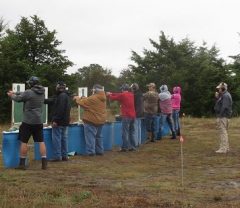The average defensive handgun user doesn’t spend much time reading about ballistics; it can be an arcane science, full of numbers, distances, and formulae. It is, however, an important topic, and one that can save your life.
Any caliber of gun will kill, even a .22 if you hit the right spot. That is not as important in defensive gun use as, will it stop the threat quickly? Some years ago, a police officer was attacked by a felon with a large knife. The cop shot him 6 times with a .38 Special. The felon died, but lived long enough to get to the cop, and kill him.
The issue at hand here is not killing power, but stopping power. That is a difficult metric to measure, but can be best expressed as energy transfer.
energy = mass x velocity
That is, given a constant speed, a larger (heavier) bullet creates more force, and greater stopping power, than a lighter bullet. The problem is, heavier bullets require more powder to achieve the same speed (ignoring for the moment that hollow-points have greater wind resistance). In fact, larger calibers do tend to use more powder to offset the greater weight, but there is a ceiling beyond which manufacturers cannot go and stay within established safety limits.
A lighter bullet traveling very fast can generate the same energy transfer as a heavier bullet going somewhat slower, but efficiency tapers off at both ends, creating what scientists call a “bell curve”. From a practical standpoint, this is complicated by the fact that larger caliber guns make rapid shooting more difficult, due to recoil affecting sight picture acquisition. For that reason, the FBI stopped using 10mm handguns (which will kill a bear), and went back to the .45, and sometimes the .40. Many police agencies have moved from the .45 all the way back to the 9mm. Even though the 9mm generates less energy, follow-up shots are quicker and more accurate, and the guns typically carry more ammo, as much as 18 rounds. No one is going to still be a threat after taking 10-18 bullets. Recent ballistic tests have shown that 9mm +P ammo generates more energy than a .40 caliber. [+P are hotter factory loads]
The lesson there is, either carry bigger bullets, or more of them.
Much of the above, however, relates to full-size service pistols and home defense guns. The person carrying a concealed weapon has to make allowance for the fact that most easily concealable guns will be smaller, lighter, or both. That affects the ability to make rapid follow-up shots, similar to the 10mm problem, but on a smaller scale. If that is not clear, try shooting a polymer snub-nosed .357 Magnum revolver.
A small .45 probably puts many people at a disadvantage, considering weight vs recoil. Add 3 points for the greater energy of the bullets, but subtract 1 point for the smaller round count. An experienced, skilled shooter could make that work to his advantage, but for many average gun owners, a good compromise would be a 9mm carrying at least 9 rounds of +P hollow-points.
Don’t overlook another devastating option: an all steel snub-nosed or 4 inch revolver loaded with .357 Magnum. That will definitely make someone change their career plans!
